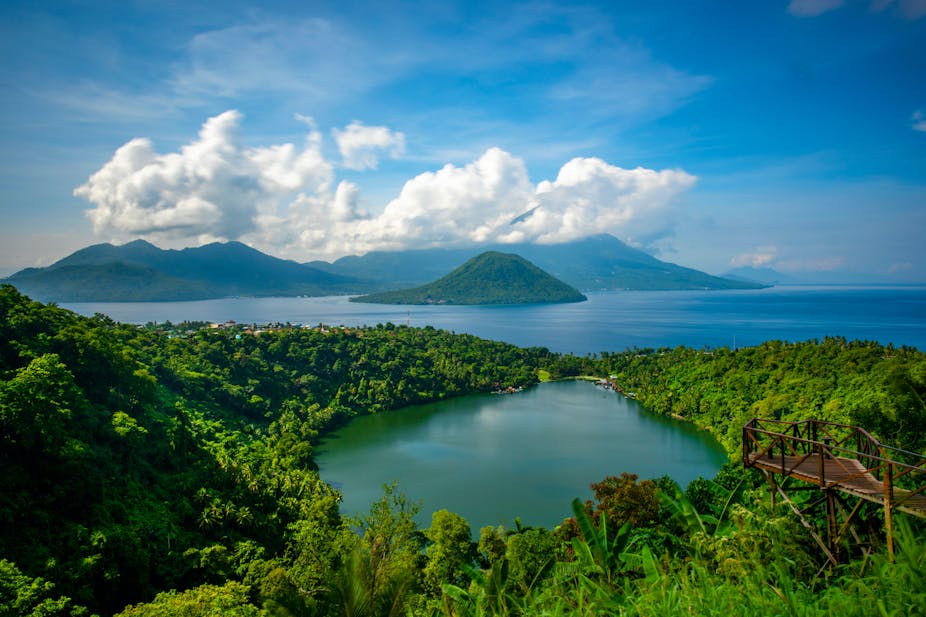During the transitional period between the Pleistocene epoch (or the Ice Age, from 2.58 million to 11,700 years ago) and the Holocene epoch (from 11,700 years ago until today), the Earth’s temperature underwent massive change.
Within this period of highly fluctuating temperatures, ice sheets in the North and South Poles melted and sea levels started rising, in a process called deglaciation.
As a result, islands in the Wallacea region in Central Indonesia shrank in size and became more isolated. The region also experienced a sudden shift in vegetation, forcing the humans living there to adapt further to this changing environment.

This unique prehistoric geography makes the Wallacean islands an ideal region for studying how humans adapted their foraging patterns to climatic changes during the end of the last Ice Age.
During September and October 2015, our team of Indonesian and Australian researchers excavated the Here Sorot Entapa rock shelter in Kisar – an island northeast of Timor in the regency of Maluku Barat Daya.
The island is rich in prehistoric remains, and our team went there specifically to study changes in prehistoric people’s dietary patterns in response to climate change.
When the climate suddenly cooled in Indonesia
Humans first occupied the cave 15,000 years ago as rising sea levels at the end of the Ice Age caused coastal ecosystems to thrive, increasing the occupation of many prehistoric sites in Wallacea.
During that initial phase, humans occupying the Here Sorot Entapa rock shelter mainly ate aquatic species including fish, turtles, shellfish and sea urchins.
However, a drastic change in climate occurred during the final stages of the Ice Age deglaciation, a period commonly known as the Bølling-Allerød (around 14,500 to 12,800 years ago). This change led to a denser human population at Here Sorot Entapa.

During that climate event, Kisar and the surrounding Wallacea islands experienced a sudden temperature drop.
As glaciers continued to melt with high temperatures in the Northern Hemisphere, the climate in Wallacea became much cooler, while at the same time sea levels continued to rise.
We found numerous remains of fish hooks fashioned out of seashells in the excavation layers corresponding to this period. These finds indicated that at that time people relied on marine resources, likely venturing out to fish in deep waters.

However, our dig also suggests Kisar’s early occupants expanded their diet to include land animals, particularly reptiles such as snakes and lizards.
These animals were able to reproduce well through this period due to their ability to survive in this period of change and colder conditions.
But then gradually it became hot again
Then, from 12,800 to 9,500 years ago, human occupation of Here Sorot Entapa shows a gradual decrease until the cave was abandoned for more than 3,000 years.
This coincided with the Younger Dryas episode, a turbulent climate event known from European records. It reversed the previous warming and deglaciation in the Northern Hemisphere, making temperatures severely drop again for hundreds of years.
Below the equator in Wallacea, however, the opposite occurred. Throughout the Younger Dryas, temperatures rose in regions close to the equator.
This condition – where the temperature became hotter while sea levels stopped rising – is probably what caused the humans of Here Sorot Entapa to leave. They perhaps migrated towards larger islands with a greater abundance of resources in order to survive.

Throughout this low-occupation period, our excavation reveals fishing activities plummeted, as foraging activities shifted to mostly land animals.
While the most hunted land animals during the previous occupation phase had been reptiles, rats became the primary choice for the rock-shelter residents.
A number of palaeontological and archaeological studies reveal the rise of the rat population coincided with increasing human activities in the early Holocene such as inter-island transport, preliminary agriculture and land clearing.
Most probably, rats came to Kisar through sea trade as they are renowned stowaways.
Toward the climatic stability of the Holocene
Based on our team’s archaeological data, the Here Sorot Entapa rock shelter was once more occupied from 5,000 to 1,600 years ago.
In this occupation phase, the Earth’s temperature gradually stabilised due to the end of the deglaciation process, until the climate reached similar levels to the present.
This Goldilocks climate – not too hot and not too cold – allowed people to thrive and develop various agricultural technologies. They also started living in larger groups and communities.
For instance, we found a high volume of pottery pieces and charcoal remains from the mid-Holocene around 4,000 years ago. These findings indicate major advances in the development of technologies for processing and storing food.
Learning from the past to prepare for the future
Through archaeology and palaeontology, we can try to understand how the environment acts as a central part of human civilisation.
Humans have managed to overcome a multitude of climatic challenges throughout their history by adapting and taking advantage of natural resources.
However, the current climate crisis has proven to be a new challenge for humanity. Forest fires, floods and erratic weather patterns seem to be the new normal.
For that reason it is now more important than ever for humanity to be wiser in managing the richness offered by mother nature. We have a responsibility to fulfil our needs for energy, food and clean water without damaging the environment.
The early communities of Kisar reflect the incredible resilience and adaptability of our species. We have the capacity to overcome the changes that we face – our history shows this to be true.
We are the “wise men”, or Homo sapiens as they say in Latin. Remain wise, or we may see our period on this Earth come to an end.


